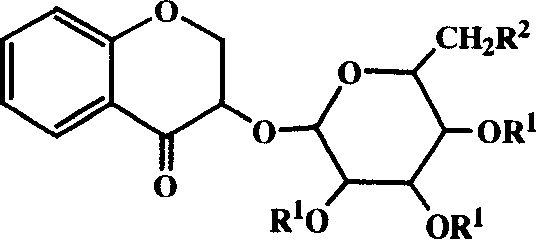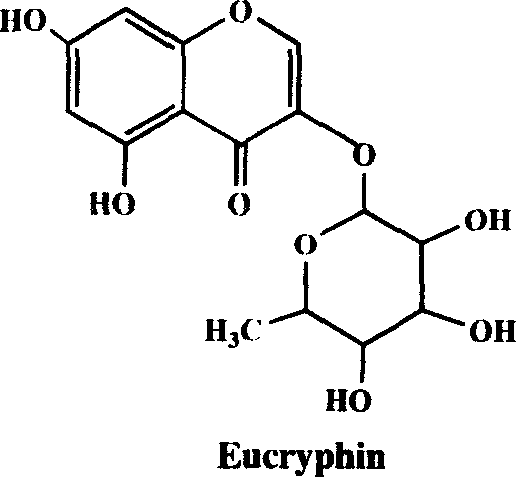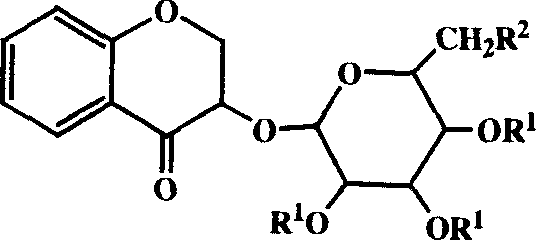3-hydroxy-chromogen ketoside and its preparation and use
A technology of proketol glucoside and hydroxyl color, which is applied in the direction of sugar derivatives, medical preparations containing active ingredients, organic active ingredients, etc., and can solve the problems that no effective methods have been reported.
- Summary
- Abstract
- Description
- Claims
- Application Information
AI Technical Summary
Problems solved by technology
Method used
Image
Examples
Embodiment 1
[0013] Embodiment 1, the preparation of 3-L-rhamnopyranosyl chromanone (VI)
[0014]
[0015] The preparation of 1.3-hydroxyl-4-chromone dimethyl acetal (II):
[0016] Chromone (I) (2.96g, 0.02mol) was mixed with 100ml of absolute anhydrous methanol, cooled to 0°C, and a mixed solution of potassium hydroxide (3.36g, 0.06mol) and 50ml of methanol was added dropwise, the solution was brownish yellow, Add in batches (4 to 5 parts) iodobenzene diacetate (C 6 h 5 IO(Ac) 2 , 7.0 g, 0.022 mol) for about 5 minutes, after which the mixture was stirred at 0° C. for 1 hour, the ice bath was removed, and stirred overnight at room temperature. After the methanol was removed by the rotary evaporator, 100ml of water and a small amount of potassium carbonate were added to the system for neutralization, and extracted 5 times with ether, about 40ml each time. Combine the organic phases, dry over anhydrous magnesium sulfate, filter to remove the desiccant, concentrate the solution to abou...
Embodiment 4
[0047] Embodiment four, the preparation of 3-D-glucopyranosyl chromone (IX)
[0048]
[0049] 1. Preparation of 3-(2,3,4,6-tetraacetyl-D-glucopyranosyl)chromone (VIII):
[0050] 3-Hydroxychromone (III) (1.853 g, 11.299 mmol) and 2,3,4,6-tetraacetyl-1-oxo-D-glucopyranosyl trichloroethylimine (VII) (5.505 g, 11.178mmol) were mixed, and after vacuum drying for 2h, 200ml of anhydrous CH was added to the mixture 2 Cl 2 , the system was cooled to -78°C in a liquid nitrogen-ethanol bath, N 2 Under protection, 250 μl of trimethylsilyl trifluoromethanesulfonate was added dropwise. After the addition was completed, the reaction system returned to room temperature gradually. 3: 2) After monitoring the reaction, triethylamine was added to the system to terminate the reaction, and the solvent was removed by a rotary evaporator to obtain a brownish-yellow viscous liquid, which was separated and purified by column chromatography (the eluent was petroleum ether: ethyl acetate =3:1) to ...
Embodiment 3
[0069] Embodiment three: Pharmacological test
[0070] 1. Effects of chromone glycosides of the present invention on unidirectional mixed lymphocyte reaction (sMLR) BALB / c and C57BL / 6 mice were taken, and splenocytes were aseptically prepared as usual. That is, aseptically remove the mouse spleen, place it in cold 5ml Hank’s solution, squeeze carefully to obtain the spleen cell suspension, centrifuge at 300g for 5min, and wash with 0.17M Tris-0.75%NH 4 Cl removes red blood cells, and then washes twice with cold RPMI-1640 (GIBCO) culture medium (containing 100 U / ml penicillin, 100 U / ml streptomycin and 10% inactivated sterile newborn bovine serum). Splenocytes from C57BL / 6 were treated with 1 × 10 -6 g / ml mitomycin C treated for 1 h, washed twice with cold RPMI-1640, and made into 2×10 6 cells / ml of cell suspension. Splenocytes from BALB / c mice were made into 2×10 7 cells / ml of cell suspension. Splenocytes from BALB / c mice 50 μl (1×10 6 ) and C57BL / 6 splenocytes treated w...
PUM
 Login to View More
Login to View More Abstract
Description
Claims
Application Information
 Login to View More
Login to View More - R&D Engineer
- R&D Manager
- IP Professional
- Industry Leading Data Capabilities
- Powerful AI technology
- Patent DNA Extraction
Browse by: Latest US Patents, China's latest patents, Technical Efficacy Thesaurus, Application Domain, Technology Topic, Popular Technical Reports.
© 2024 PatSnap. All rights reserved.Legal|Privacy policy|Modern Slavery Act Transparency Statement|Sitemap|About US| Contact US: help@patsnap.com










